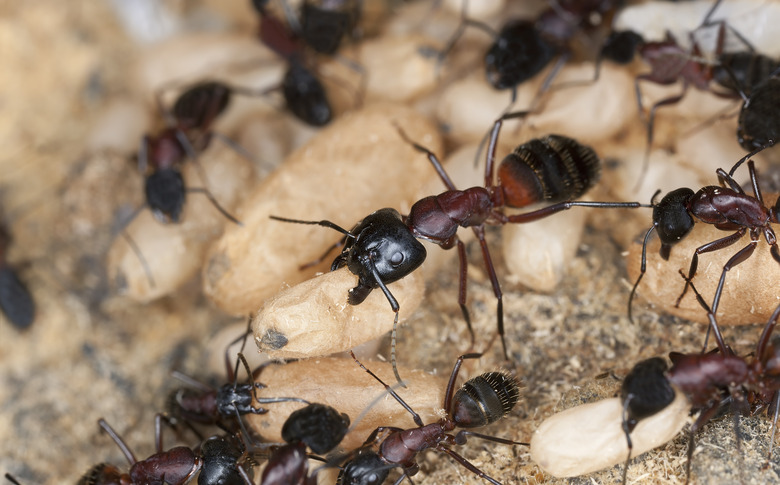How To Tell The Difference Between Fire Ants & Regular Ants
A bite from a fire ant is quite painful, and feels much like pressing a lit match against the skin. While only about one percent of the human population is allergic to fire ant venom, multiple bites from a disturbed colony can cause severe reactions in anyone. To protect yourself, children and pets, it's important to recognize and control fire ants before someone suffers a bite. This can be tricky, since not all fire ants are red and not all red ants are fire ants. Proper ant identification requires a much closer look.
Appearance of Fire Ants
Appearance of Fire Ants
There are five species of fire ants in the United States, ranging in color from bright red to black. These species are:
- Native Southern fire ants (Solenopsis xyloni)
- Tropical fire ants (Solenopsis geminat)
- Desert fire ants (Solenopsis aurea and Solenopsis amblychila)
- Little fire ants (Wasmannia auropunctata)
- Red imported fire ants (Solenopsis invicta)
All but the red imported fire ants are native ant species to the United States. The red imported fire ant was accidentally brought to the United States around 1930 and is a problematic invasive species. These five ant species vary in size as well as color, ranging from 1/8 inch to 1/4 inch in length.
Although fire ants do vary in color and size, they have other identifying features in common. Unlike other ants, fire ants have two bumps, called petioles, between their thorax and abdomen. Fire ants have an elbow, or bend, in their antennae like other ants. They are unique, however, in the fact that each antenna has ten distinct segments, with the elbow in the first segment. The remaining nine segments occur after the bend.
Color and size alone are not enough to distinguish fire ants from other ant species, and identifying them by appearance requires close contact. Fortunately, there are methods of identification that don't require such an intimate examination.
Where Fire Ants Live
Where Fire Ants Live
The location of ants is an indicator of whether or not they are fire ants. Fire ants like a warm climate and live comfortably throughout the Southern states. Imported fire ants have been found as far north a Maryland, Missouri and Kentucky, but this is rare. If you live in a Northern state, you're probably not dealing with fire ants. You could encounter them if you live in Alabama, Arkansas, California, Florida, Georgia, Louisiana, Mississippi, New Mexico, North Carolina, Oklahoma, South Carolina, Tennessee, Texas or Virginia, where fire ants are known to live.
You can also recognize fire ants based on where they nest. Fire ants build soil mounds ranging from small bumps to 18 inches in height. These mounds do not have an opening on the top like regular anthills, and are usually located in moist areas like riverbanks and irrigated lawns. Mounds may appear in your lawn after a period of rain.
Identify Fire Ants By Behavior
Identify Fire Ants By Behavior
Fire ants may look like other ants, but they don't act like them. Fire ants are far more aggressive. When a fire ant nest is disturbed, ants begin rapidly pouring out of the mound, looking for a fight. If you've found an anthill and aren't sure if you have fire ants, test the ants' behavior by disturbing the nest. Of course, doing so with any part of your body is not recommended.
Poke at the mound with a long stick, pole or shovel, and then move away quickly so the ants don't use the tool as a bridge to get to you. If the mound is a fire ant nest, ants will begin swarming almost instantaneously. Other ant species will take longer to respond, if they do respond at all. Fire ants also tend to climb vertical surfaces when disturbed, so look for them to climb grass blades, sticks and other debris around the ant mound. This method isn't very scientific, but it is an effective form of fire ant identification.
Collecting Ant Specimens for Identification
Collecting Ant Specimens for Identification
If you're still not sure what native ant species you're dealing with, collect a few ants to take to your local exterminator or extension office for identification. To do so, pull on a pair of rubber work gloves and dust them with baby powder or talc to prevent the ants from climbing the surface. Fill a vial or small jar about halfway with rubbing alcohol, and gently place it into the top of the anthill. When the ants come to explore, they will climb up the outside of the jar and fall into the alcohol, where they will die. Once you have about 30 ants in your jar, quickly remove it from the mound and place a lid on it. Rub the lidded jar in the grass to remove any ants from the outside, and take your sample to a professional for identification.
TL;DR (Too Long; Didn't Read)
Consider leaving your fire ants untouched if they are a native species. Unnecessarily removing native fire ants reduces competition and makes it easier for the more aggressive imported fire ants to move into the territory.
Cite This Article
MLA
Miley, Michelle. "How To Tell The Difference Between Fire Ants & Regular Ants" sciencing.com, https://www.sciencing.com/how-to-tell-the-difference-between-fire-ants-regular-ants-13407106/. 30 September 2021.
APA
Miley, Michelle. (2021, September 30). How To Tell The Difference Between Fire Ants & Regular Ants. sciencing.com. Retrieved from https://www.sciencing.com/how-to-tell-the-difference-between-fire-ants-regular-ants-13407106/
Chicago
Miley, Michelle. How To Tell The Difference Between Fire Ants & Regular Ants last modified March 24, 2022. https://www.sciencing.com/how-to-tell-the-difference-between-fire-ants-regular-ants-13407106/

